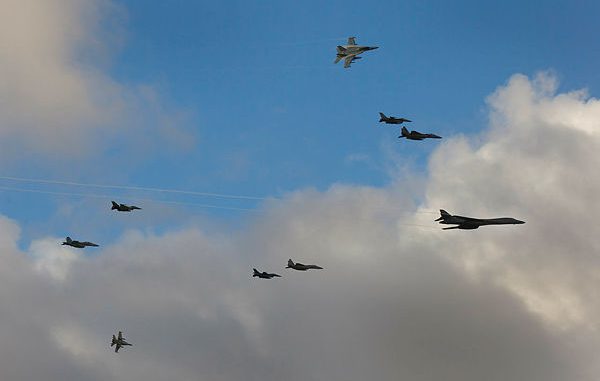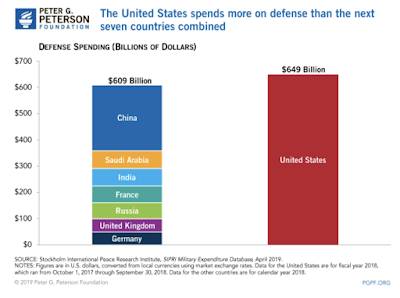
A fascinating recent study by Christopher Dougherty entitled "Why America Needs a New Way of War" at the Center for a New American Security or CNAS looks at a thought-provoking reality; what if the United States lost its next war. While its so-called wins since the end of the Second World War have been, at the very least, contestable (think Korea, Vietnam and both Afghanistan and Iraq that have been dragging on for nearly two decades), this study looks at the implications of an American loss in a large-scale war with a great power, a battle that will be far different than the relatively small scale regional wars fought in the last half of the twentieth century and the first decade of the twenty-first century.
There is no doubt that Americans (and many others around the world) have grown accustomed to America's military superiority and its ability to both deter potential opponents and police the world at the same time. That said, even though the United States has the world's most powerful and expensive armed forces in the world as shown here:
…and here:
…according to the author, the possibility of an American defeat is real and growing. Gone are the days of U.S. military dominance that was prevalent in the post-Cold War era. While both Russia and China have been developing new concepts and strategies for defeating the United States, they have been able to offset their respective weaknesses by using both time and a lack of geographic proximity. This has allowed both nations to develop strategies that will allow them to attack vulnerabilities in American military operations by avoiding what would be considered to be a "fair fight".
Here is a quote from the author that succinctly outlines the problem facing Washington:
"Unfortunately, the DoD’s responses to the many challenges posed by the emerging security environment have thus far been piecemeal and lethargic, largely because the Pentagon has failed to fully grasp the systemic nature and fundamental implications of the problem it faces: The American way of war that emerged following the Cold War will not work in an era of great-power competition. It rests on a foundation of strategic and operational assumptions that were the product of an anomalous historical period of unchallenged U.S. military dominance. The assumptions from that period are now deeply flawed or wholly invalid and must be updated for an era of great-power competition.
This has led to the situation in which U.S. armed forces are the most powerful in the world by a wide margin, and yet they increasingly run the risk of losing a future war with China or Russia. The root of the problem is the DoD’s unwillingness thus far to fully come to grips with the reality that its principal competitors are no longer regional threats such as the Iraqs and Yugoslavias of the world, but rather great powers with advanced military forces and the ability to match U.S. escalation." (my bolds)
Let's look at the current "way of war". Here are the steps that are currently used by the United States to wage war against an adversary:
1.) Maintain a “tripwire” forward presence for peace-time shaping operations.
2.) Increase presence during crises through “flexible deterrent operations (FDOs).”
3.) Rely on basing access and overflight from allies, partners, and other states in the theater.
4.) Exploit sanctuary in the homeland and other theaters to deploy forces without threat from enemy attack.
5.) Build up and sustain expeditionary forces in the theater over weeks or months, and marshal forces at concentrated land and sea bases and staging locations close to enemy territory.
6.) Conduct extensive intelligence preparation of the battlespace.
7.) Commence offensive operations at the time and place the United States chooses.
8.) Attack regime targets and command, control, communications, computing, intelligence, surveillance, and reconnaissance (C4ISR).
9.) Establish aerospace, information, and maritime dominance throughout the theater.
10.) Attack the adversary’s fielded forces and critical infrastructure to degrade its forces, erode its will to fight, and systemically disrupt the cohesion of the regime and its military.
11.) Conduct ground operations once enemy forces are heavily outnumbered, degraded, and disorganized.
12.) Combine precision firepower with rapid maneuver—enabled by information dominance and mostly secure lines of logistics—to fix and annihilate enemy forces and seize key terrain with minimal U.S. casualties.
13.) Exploit other levers of power (diplomacy, information and economics) for coercive leverage (think sanctions).
This model of war has worked well in the post-Cold War era when most of America's adversaries were rogue states that were relatively weak militarily, particularly when compared to the United States. This model may not work as well in the case of a war fought with a larger and more powerful military peer since it will require the Joint Force to deploy large forces to deter its much larger adversary in a scenario where there is competition for the status of a "great power". The author notes that this is particularly evident in the very rapid modernization of China's People's Liberation Army which now presents an even more striking challenge to America's global dominance. He also states that both China and Russia have developed strategic counterpoints to America's preferred model of warfare. that of the expeditionary model which requires the marshalling of hundreds of thousands of military personnel and accompanying materiel over a period of weeks or months. As well, the mere presence of U.S. forces in a particular region of the world will no longer deter aggression. It has become a rather subtle change; rather than "will the United States intervene" it has become a "can the United States intervene?".
Given the close and lasting economic, political and cultural relationship between Russia and China as well as between both nations and their geographic neighbours, the situation has become far more complex than it was three decades ago when the Soviet Union imploded. The United States military is no longer the only "big kid on the block" and cannot count on its traditional allies to back it in a war against one of the great powers given the interrelationships between Russia, China and the rest of the world.
Here is a summary of what a war with China or Russia would look like:
"Absent changes to U.S. force posture and operational concepts, the opening rounds of war with China or Russia are likely to have more in common with 1941 than 1991. China and Russia have witnessed the folly of ceding the initiative to the United States and will orient their strategy and operations toward preventing an effective U.S. response. Both likely will attempt to leverage non-military aspects of power—particularly information operations—and covert, clandestine, and sub-conventional forms of coercion to confound U.S. indications and warning and set the battlespace and terms of engagement to their advantage. Should these efforts succeed, China and Russia may be able to achieve their objectives without resort to combat, or at least direct conflict with the United States. Should these efforts fail, China and Russia would be able to dictate the terms of the fight to a large extent, at least initially.
Rapid, and possibly preemptive attacks against U.S. and allied C4ISR would leave U.S. commanders scrambling for situational awareness and a means to coordinate an effective response. These attacks may be limited and non-kinetic to avoid escalation, or they may be broader and destructive to achieve a knockout blow or, failing that, signal willingness and capability. In any case, the United States would not be dictating the scope, scale, location, or timing of the conflict. Amid the resultant chaos, China and Russia may seek to seize key objectives and offer to negotiate an end to hostilities in order to undermine the political will of the United States and its allies and partners. Both powers may contrast this diplomatic offer with implicit or explicit threats of escalation to further strain a U.S.-led coalition.
As opposed to methodically building a coalition and marshaling overwhelming force as in the Gulf War, U.S. political leaders and commanders might resemble their World War II counterparts—looking to stem the bleeding, keep critical allies and partners onside, and counterpunch until they can stabilize the situation. The ability of China and Russia to expand and escalate these conflicts using both military and non-military means would complicate U.S. efforts to seize the initiative through vertical or horizontal escalation." (my bolds)
It sounds rather grim, doesn't it?
Let's close with this quote from the author:
"Today, the global order is weakening. Many in the United States and allied and partner nations only see the costs and burdens of this order in the form of military obligations, regulations, and multilateral organizations. The benefits are often diffuse and the original catastrophes that spurred its creation are increasingly lost in the mists of history. Meanwhile, China seeks to create an alternative Sino-centric order in Asia, and Russia seeks to undermine the U.S.-led order at every turn. Should these efforts prove successful, it could mark a return to the harsh zero-sum competitions between political-economic blocs that led to global cataclysms in the past. To paraphrase Mark Twain, the history of the early 20th century may not be repeating itself today, but it certainly appears to be rhyming."
There is one thing that we can count on; we are entering a new multipolar geopolitical reality, a reality that could well mean the defeat of the world's current leading military power. The old ways of fighting a war are no longer valid and, until Washington comes to the realization that their strategy no longer works, there is a great risk that the United States could find its position at the top of the world's "military heap" under significant threat.
Click HERE to read more from this author.
You can publish this article on your website as long as you provide a link back to this page.



Be the first to comment